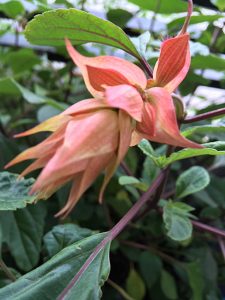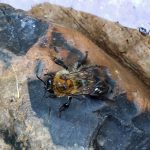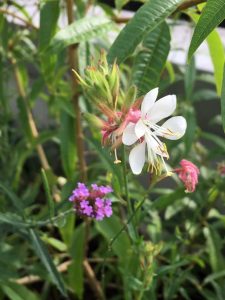Bare Earth
So the question might be why did the two words ‘#BareEarth’ come together in my mind and linger long enough to start a train of thoughts that meandered through the snatched statistics extracted from reports and communiqués from a recent environmental conference, to the trials and tribulations of allotment gardening and back to my balcony and blog, which began as a somewhat self aggrandizing attempt to reduce the number of bare balconies in my natural habitat of South West London?
In fact, the proportion of local balconies and roof gardens that this season is resplendent with pots and plants of all sorts has steadily increased, and I am pleased to say so has the range of readers of my blog which I am reliably told now includes South Africa, so thank you; but there is of course no connection between the two. And on the balcony at this time of year bare earth would be welcome as I am missing the arrival of sedums to extend and expand supplies of late summer food for visiting insects, as w ell as add late summer charm. But to find bare earth or an empty pot means ousting something prematurely from its summer residence. Of course things have fallen by the way-side: the chives have all struggled, only one of my treasured lemon verbena plants grew to a mature height, and the strawberries were smothered by pelargoniums and hardy geraniums. While on the allotment bare earth is all too visible as mid-season crops have come and gone and their replacements are still in their infancy.
ell as add late summer charm. But to find bare earth or an empty pot means ousting something prematurely from its summer residence. Of course things have fallen by the way-side: the chives have all struggled, only one of my treasured lemon verbena plants grew to a mature height, and the strawberries were smothered by pelargoniums and hardy geraniums. While on the allotment bare earth is all too visible as mid-season crops have come and gone and their replacements are still in their infancy.
So the ambition is to become familiar with green manure and perpetual spinach, which I hope lives up to its name, and at this time of year to allow the butternut squash to continue sprawling across neighbouring strips. Allotment plots tend to be divided into strips https://bkthisandthat.org.uk/brief-history-of-allotments-in-england/. We have twelve but at any one time are probably only in full command of eight or nine, unlike our neighbouring allotmenteer who has a number of allotments in this five acre site, in part by way of an informal process of sub-letting. However, he helps the common cause by keeping his whole domain in remarkably full production. The site is surprisingly somewhat undersubscribed but is a haven for birds and insects as well as the resilient and unwelcome Mare’s Tail. By custom, excess fruit and veg is left on a nearby wall for anyone to pick up and enjoy although once the courgette season has passed it is a less reliable food source.
An end of season review would also have to conclude that my first proprietorial year of flower-strip responsibility has been very mixed. Sweet smelling, long lasting and long flowering sweet peas filled the kitchen for several weeks, while a cherry (more fruit than flower of course) and a bush honeysuckle that will hopefully flower this winter, have both been successfully transplanted from the balcony, relieved no doubt that they are now in more appropriate surroundings. The sole survivor of the original group of sunflowers reared aloft has reached the stage of seed production which will hopefully please the birds, but both stocks and cosmos for different reasons were a failure. I selected stocks that were labelled as ‘multi-coloured’ or something of the sort, imagining a mixture of purple, pink and yellow flowers, not quite my taste but unquestionably colourful, not expecting that all three of the differently coloured flower heads would appear Medusa like on one (stunted) plant. I will read the label more carefully another time. The cosmos were planted out too early and never recovered, but a late crop of radicchio has formed a pretty pink circle at the foot of the cherry tree.
Meanwhile, on the balcony, although two of the three olive trees are continuing to put on plenty of extension growth which will need to be watched and in time reduced again, there will be no crop of ripening fruit this year. The intense and persistent summer heat of last year being noticeably absent.
Making a bee-line
It is Sunday, and for those who are interested in these things, the fifth and final day of a rain affected Ashes (cricket) match at Lords, a few miles to the North of my cloud- covered balcony. The rain is due in twenty minutes, or so we are told by the attentive cricket commentators, and now the day will be shaped by the adjusted opportunities for play. But what is more astonishing than the extraordinarily vivid and garish MCC colours, which are a clash of orange and yellow that nature and my favourite garden designers would do much better, is the tenacious grip that the solitary and bumble bees have on their flowers of choice while the wind gathers force ahead of the wet weather. Do they live amonst the jungle on my roof garden, do they fly up from the well kept but rather sterile communal gardens below, or do they make the journey from further afield? Answers please on a post-card or a comment on the blog.
One of my over-wintering resolutions is to study the different identifying characteristics of the foraging bees that I hope are making some use of my soon to be renovated bee ‘hotels’, due for a re-fit to provide a greater variety of accomodation.
 I’m taking as my guide July’s edition of ‘The Garden’ and an article by Jean Vernon based on her new book, ‘The Secret Lives of Garden Bees’ https://www.goodreads.com/book/show/47355575-the-secret-lives-of-garden-bees. Unfortunately, I haven’t got past first base as the whole process of indentification (birds, butterflies and now bees) always has me foxed. The yellow bands of the garden bumblebee (Bombus horturum) look to my untutored eye remarkably similar to the gingery thorax of the common carder bee (Bombus pascuorum). I’m more confident that leafcutter bees (Megachile species) have been visiting as evidence of smooth, circular leaf damage is, happily, everywhere.
I’m taking as my guide July’s edition of ‘The Garden’ and an article by Jean Vernon based on her new book, ‘The Secret Lives of Garden Bees’ https://www.goodreads.com/book/show/47355575-the-secret-lives-of-garden-bees. Unfortunately, I haven’t got past first base as the whole process of indentification (birds, butterflies and now bees) always has me foxed. The yellow bands of the garden bumblebee (Bombus horturum) look to my untutored eye remarkably similar to the gingery thorax of the common carder bee (Bombus pascuorum). I’m more confident that leafcutter bees (Megachile species) have been visiting as evidence of smooth, circular leaf damage is, happily, everywhere.
Fading Glory
The best vantage point for enjoying the plants and associated wild-life on the terrace at this time of year is now, somewhat regretably, often looking out from the main bedroom rather than perching awkwardly amidst the abundant greenery, which I notice includes late-flowering roses and some  rather pretty, but largely hidden fuschias. Although forgotten, I hope they will now enhance the late Summer display, but I’m not a huge fan, and didn’t choose wisely and well, so we’ll see. Salvias on the other hand are a favourite and seem to be extremely happy in their varied colours and sizes, reliably coming back year after year and will flower up till Christmas if previous experience is anything to go by.
rather pretty, but largely hidden fuschias. Although forgotten, I hope they will now enhance the late Summer display, but I’m not a huge fan, and didn’t choose wisely and well, so we’ll see. Salvias on the other hand are a favourite and seem to be extremely happy in their varied colours and sizes, reliably coming back year after year and will flower up till Christmas if previous experience is anything to go by.
My wish for time to stand still, for a moment, in these poignant last moments of high summer, lingers alongside thoughts of new possibilities, new planting ideas, new colour combinations. All of which is echoed in the seasonal and herbaceous plants, already beginning the annual retrea t, and creating space for the Autumn planting.
t, and creating space for the Autumn planting.
Meanwhile the seduction has also begun as catalogues are arriving by post and e-mail, with alluring pictures of gardens in Spring with blossom and bulbs to delight the senses. I began a list a few days ago of the tulip bulbs I wanted to buy, topped by China Town and La Belle Epoque, both of which are good in pots, last a long time and are not too tall for this windy spot. But it seems too early to be writing shopping lists when there is much to enjoy even on this space-limited spot.
I was unsuccessful with snake’s head fritillary (Fritillaria meleagris) last year but a very kind cousin has gathered some seed for me which I hope I can coax into life. Always susceptible to pretty planting combinations I am also hoping to pair the fritillaries (spelling?) with some other slim stemmed Spring flowers in anticipation of the bees next year. Apparently snake’s head fritillaries secrete nectar with a higher sugar concentration than most other bulbs so well worth the effort, and I have the right spot, a long way of course from a riverside meadow, but in good view, in a rather handsome terracotta pot and adequately exposed to the winter rains.
Last Words
Some experimentation is to be recommended – how else would I have discovered that underplanting E Nicholii (my miniature eucalyptus) with thyme and other herbs left to flower through the summer has been a favourite spot for bees and other pollinators. The combination of herbs and delicately fronded tree has been a visual treat as well as a sensory delight with the characteristic smell of eucalyptus oil sometimes mingly gently with the fragrant thyme.
The temptation to cram too many plants into too little space, and than wait to see what happens, has only been a partial success this year as the discrepancy between plants enjoying cooler damp conditions, and those wanting heat and light was this year heavily weighted in favour of those preferring a cooler climate and the gaura in particular lost out.
And I won’t be trying to grow chillies again.








